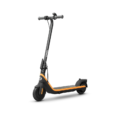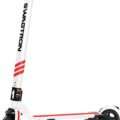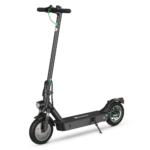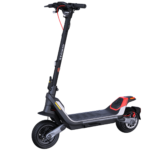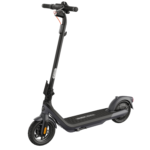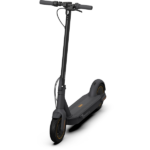- Home
- Scooters
- Electric Scooters
- Segway Ninebot GT2
Segway Ninebot GT2



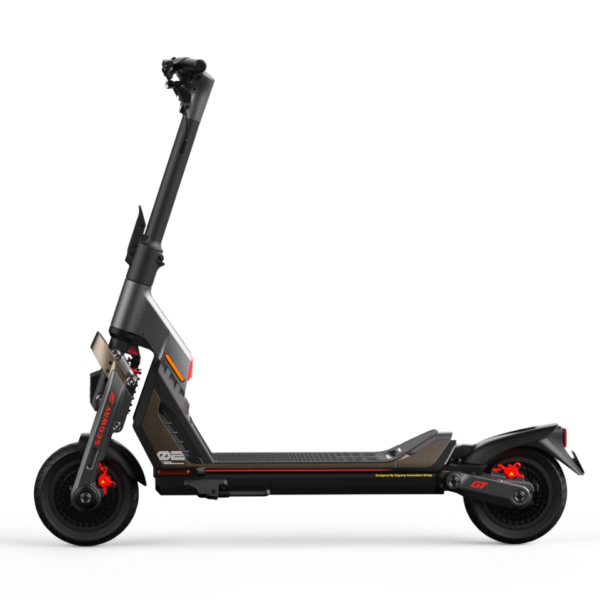
- Battery Range: 90 km
- Top Speed: 70 km/h
- Motor Power: Dual hubs; 6000 W peak (combined)
- Weight Capacity: 150 kg
- Charging Time: ≈8 h
- Scooter Weight & Portability: 52.6 kg
PROS
- 1512 Wh battery with up to 90 km rated range
- Dual-motor 2WD with selectable 1WD/2WD
- Dual hydraulic discs, E-ABS regen, and transparent PM-OLED dash
CONS
- EU speed capped at 25 km/h
- Heavy at ~52.6 kg compared to commuter-class models


Overview
Segway Ninebot GT2 Specifications — Scope of This Page
This page focuses on the Segway Ninebot GT2 specifications. It explains the hardware, software, and regional variations so buyers can match figures to real routes. Importantly, it is not a review. Instead, it groups the data needed for comparisons: battery and range, motors and speed, braking and suspension, dimensions and weights, lighting and indicators, app features, and compliance notes. Consequently, the text uses neutral language and emphasizes measurable attributes.
The GT2 belongs to Segway’s SuperScooter line. Unlike single-motor commuters, the GT2 uses dual hub motors with selectable 1WD/2WD. Additionally, it carries a 1512 Wh battery, dual-arm suspension with adjustable hydraulic damping, and dual hydraulic discs with electronic regenerative braking. Because regional rules differ, EU-labeled models cap speed at 25 km/h, whereas GT2P units in other markets support higher limits where legal. Therefore, always confirm your suffix and local regulations.
Battery Capacity and Energy Management
The GT2’s energy store is 1512 Wh (52 V class, 30 Ah). In practical terms, that capacity supports long urban trips, hilly detours, and repeated accelerations. Manufacturer range figures reach up to 90 km under steady, favorable conditions. However, real range varies with speed, rider mass, elevation, temperature, and wind. For that reason, plan with a conservative buffer if you ride fast or in winter. The Smart BMS monitors cell voltage, temperature, and current and coordinates protection against short circuit, over-charge, and over-discharge.
Additionally, the controller coordinates regenerative braking on deceleration. Regen does not replace charging, yet it recovers energy on rolling routes and long descents. Furthermore, users can adjust regen intensity in the app to favor longer coasts or stronger slowing. Because regeneration is electronically modulated, transitions remain smooth as speed changes.
Motors, Drive Strategy, and Speed Management
The GT2 uses two hub motors and supports selectable one-wheel drive and two-wheel drive. Accordingly, riders can cruise in 1WD for efficiency, then select 2WD when traction or thrust matters. Marketing materials cite up to 6000 W combined peak. While peak figures vary by region and firmware, the operating strategy is consistent: dual motors shorten 0–30 mph sprints and stabilize climbs. EU models observe legal caps; GT2P units outside capped markets list higher limits, up to 70 km/h where permitted.
Modes shape output envelopes. Specifically, Park and Walk limit movement for safety in crowds and garages. Meanwhile, Eco reduces acceleration and trims peak speed for range. By contrast, Sport increases thrust for merges and hills. Moreover, Race prioritizes performance when rules and space allow. On supported variants, Boost provides a brief power spike. Because these are software envelopes, switching modes changes behavior without mechanical adjustments.
Braking Hardware and Electronic Control
Stopping hardware includes dual hydraulic discs and electronically managed regenerative braking (E-ABS logic). As a result, hydraulic systems provide consistent lever feel and thermal management on repeated stops, while electronic regen adds steady drag and harvests energy. In addition, the system’s logic coordinates front and rear behavior to keep deceleration predictable across surfaces. For repeatable results, keep rotors clean, check pad thickness, and confirm lever travel. Because braking is ultimately limited by tyre grip, correct pressures remain essential.
Service notes are straightforward. First, inspect caliper alignment. Second, check for rub and watch for glazing under heavy use. Third, replace pads at indicator thickness and bed new pads using progressive stops. Taken together, these steps keep measured stopping distance close to spec over time.
Suspension Architecture and Damping
The chassis employs front and rear dual-arm geometry with adjustable hydraulic damping. This way, steering inputs are separated from vertical wheel motion and tyres track over repetitive seams. Consequently, riders can tune rebound and compression to payload and surface texture. Typically, heavier riders add damping to control oscillation, whereas lighter riders may reduce damping for comfort at lower speeds. Because geometry remains stable through travel, the GT2 maintains steering accuracy at city pace and beyond.
Setup guidance is simple. Start at factory default. Then, add clicks of damping if the front rebounds too quickly over patterned concrete. Conversely, reduce damping if the ride feels harsh on small, frequent ripples. Finally, recheck tyre pressure after changes; pressure and damping interact strongly.
Tyres, Puncture Management, and Contact Patch
The GT2 uses 11-inch tubeless tyres with a self-sealing jelly layer. Consequently, tiny intrusions often seal before pressure loss strands you. Moreover, the larger carcass volume allows compliant pressures that preserve comfort while sustaining a wide contact patch. Nevertheless, under-inflation increases heat and rolling resistance; conversely, over-inflation reduces grip and braking confidence. Therefore, weekly checks with a reliable gauge protect range and steering predictability. When changing tyres, keep rolling diameter consistent to preserve indicated speed and controller calibration.
Lighting, Indicators, and Conspicuity
Lighting specifications include a front LED headlight with DRL, a rear brake light, and integrated front and rear turn indicators. Together, indicators communicate intent clearly at intersections and during lane merges. Because the controls sit near the grips, riders can signal without reaching away from brakes. To stay objective, this page avoids subjective brightness claims; instead, it lists the equipment present so buyers can confirm compliance for their region. If necessary, add auxiliary lights only if local rules allow and mounting leaves controls unobstructed.
Display, Controls, and App Functions
A transparent PM-OLED color dashboard shows speed, battery, mode, lighting, indicator status, and 1WD/2WD selection. Accordingly, readability is tuned for day and night. Furthermore, Bluetooth connectivity to the Segway Mobility app enables firmware updates, diagnostics, regen tuning, mode caps, and locking functions. Additionally, the app exposes health data the BMS records, which helps plan service intervals. Because settings persist, riders configure once and ride without daily fiddling.
Dimensions, Mass, and Storage
Unfolded size is 1485 × 656 × 1308 mm; folded size is 1485 × 656 × 860 mm. The listed mass is approximately 52.6 kg. Practically, these numbers matter for elevators, car trunks, and home storage. Although the fold is positive and quick, the platform favors rolling over carrying. For that reason, plan storage near ground level when possible. If stair carries are frequent, consider ramps or lighter models. Nevertheless, mass contributes to on-road stability and crosswind resistance.
Water Protection and Seasonal Notes
The GT2 carries an IPX4 vehicle rating. Thus, it indicates splash resistance. It is not designed for submersion or pressure washing. After wet rides, wipe contact points dry and store the scooter where moisture can evaporate. Moreover, cold weather reduces available energy, while high heat can stress cells. Therefore, avoid charging at temperature extremes and moderate speed in freezing conditions. These habits, in turn, keep range closer to listed figures.
Compliance, Suffixes, and Regional Differences
Suffixes identify configuration. In EU markets, the GT2 variant caps speed at 25 km/h and includes region-specific reflectors and labeling. In other regions, GT2P products support higher limits where legal. Additionally, lighting, horn behavior, and indicator requirements follow local rules. Before purchasing, check product labeling and match the specifications to your jurisdiction. This approach ensures correct expectations and avoids issues with enforcement.
Use-Case Mapping Against Specifications
Dual motors and 1512 Wh capacity suit long urban loops, steep neighborhoods, and mixed traffic density. At the same time, adjustable suspension and 11-inch tubeless tyres smooth patched asphalt and concrete seams. Likewise, dual hydraulic discs with regen provide stopping headroom for heavy riders and cargo. Meanwhile, app features expose diagnostic detail for proactive maintenance. Dimension-wise, the chassis fits elevators and large trunks, yet mass discourages frequent stair carries. Because these traits are specification-led, they remain consistent across riders once settings are dialed in.
Frequently Referenced Numbers
Battery: 1512 Wh. Claimed range: up to 90 km. Motors: dual hubs, up to 6000 W combined peak (region dependent). Top speed: up to 70 km/h on GT2P, 25 km/h on EU models. Slope: up to 30%. Suspension: front and rear dual-arm with adjustable hydraulic damping. Brakes: dual hydraulic discs with electronic regen. Tyres: 11-inch tubeless, self-sealing. Water protection: IPX4. Weight: ~52.6 kg. Max rider weight: 150 kg. Size: 1485 × 656 × 1308 mm unfolded; 1485 × 656 × 860 mm folded.
In summary, these values present the Segway Ninebot GT2 specifications without commentary. For decisions, pair the numbers with your route length, climate, and storage plan. Because the GT2 scales with modes and damping, one chassis can meet multiple scenarios once configured correctly.
Specifications
General
| Model The Model specifies the exact version or name of the scooter. It helps identify its unique design, features, and specifications within the manufacturer’s product line. Knowing the model makes it easier to compare options, find compatible accessories, or look up support information. | Ninebot GT2 |
| Brand The Brand identifies the manufacturer or company that designs and produces the scooter. A trusted brand is a sign of quality, reliability, and good customer support. Well-known brands often have higher standards for safety, performance, and after-sales service, giving you more confidence in your purchase. | Segway |
| Release Date The Release Date indicates when the scooter model was officially launched on the market. This helps you know how current the design, technology, and features are. A newer release date often means updated components, improved performance, and the latest safety or smart features. | 17 November 2025 |
| Recommended Age Recommended Age indicates the minimum age range that the scooter is designed for, based on safety, size, and ease of use. Following the recommended age helps ensure that riders can handle the scooter’s speed, weight, and controls comfortably and safely. Always check local laws and use protective gear, especially for younger riders. | 16+ |
Performance & Power
| Motor Power (Wattage) What it means: The motor power, measured in watts (W), shows how strong the scooter’s electric motor is. Why it matters: Higher wattage usually means better acceleration, more torque, and improved performance on hills or rough terrain. For example, a 250W motor is good for flat city roads and light riders, while a 500W or 1000W motor provides more power for faster speeds or climbing steep inclines. | Dual 1500 W nominal (per motor) / up to 6000 W peak (combined) |
| Top Speed The Top Speed indicates the maximum speed that the scooter can reach under optimal conditions. It’s usually measured on level ground with a fully charged battery and an average rider weight. A higher top speed allows you to travel longer distances faster, but always ensure you ride within legal speed limits and your personal comfort zone for safety. | 70 km/h (region dependent) / 25 km/h (EU) |
| Battery Capacity Battery Capacity refers to the total amount of energy the scooter’s battery can store, usually measured in ampere-hours (Ah) or watt-hours (Wh). A higher battery capacity means you can ride longer distances on a single charge, reducing the need for frequent recharging. Keep in mind that actual range can vary depending on rider weight, terrain, speed, and weather conditions. | 1512 Wh (52 V class, 30 Ah) |
| Estimated Range per Charge The Estimated Range per Charge indicates the average distance the scooter can travel on a single full battery charge. This range is calculated under optimal conditions, such as flat terrain, moderate speed, and average rider weight. Real-world range may vary depending on riding style, terrain, weather, and load. A longer range means fewer recharges and greater freedom for longer trips. | Up to 90 km (manufacturer rated) |
| Hill Climb Ability Hill Climb Ability describes the maximum incline or slope that the scooter can handle while maintaining stable performance. It’s typically expressed as a percentage or in degrees. A higher hill climb rating means the scooter can tackle steeper hills without losing too much speed or power. Actual climbing performance may vary based on rider weight, battery charge, and terrain conditions. | Up to 30% slope |
| Drive System The Drive System refers to how power from the motor is delivered to the wheels. Electric scooters typically use either a hub motor (directly integrated into the wheel) or a chain/belt drive system. A high-quality drive system ensures smooth acceleration, efficient power transfer, and low maintenance. The choice of drive system affects performance, noise level, and overall ride experience. | 2WD (dual hub motors), selectable 1WD/2WD |
Charging & Electrical
| Charging Time Charging Time indicates how long it takes to fully recharge the scooter’s battery from empty to 100% using the standard charger provided. Faster charging means less downtime and more time on the road. Actual charging time may vary slightly depending on battery capacity, charger output, and environmental conditions. | ≈8 hours (dual-charging support) |
| Battery Type Battery Type refers to the specific technology used in the scooter’s battery, which affects performance, lifespan, weight, and charging time. Most modern electric scooters use high-quality lithium-ion (Li-ion) batteries because they offer a good balance of energy density, durability, and low maintenance. A reliable battery type ensures consistent power delivery and longer riding ranges. | Lithium-ion with Smart BMS |
| Removable Battery A Removable Battery means the battery pack can be easily detached from the scooter for convenient charging and replacement. This feature allows you to charge the battery separately, swap it with a spare for extended range, or securely store it indoors in extreme weather. Removable batteries add flexibility and make it easier to keep your scooter powered up wherever you are. | No |
| Regenerative Braking Regenerative Braking is an energy-saving feature that converts some of the energy normally lost during braking back into battery power. When you slow down or brake, the motor works in reverse to generate electricity, which helps extend the scooter’s range and improves overall efficiency. This system also reduces wear on traditional brake components, leading to lower maintenance over time. | Yes — electronic regenerative (E-ABS logic) |
| Lighting Lighting refers to the built-in front and rear lights that enhance visibility and safety when riding in low-light conditions or at night. Good lighting helps you see the road ahead and ensures that other road users can see you. Many scooters include LED headlights, taillights, and sometimes brake lights or side reflectors for added safety and compliance with local traffic regulations. | Front LED headlight + DRL, rear/brake light, front & rear indicators |
Build & Dimensions
| Scooter Weight Scooter Weight refers to the total weight of the scooter when fully assembled, including the battery. This affects how easy it is to carry, lift, and store the scooter when not in use. A lighter scooter is more portable and convenient for commuting, especially if you need to carry it upstairs or onto public transport. Keep in mind that a sturdy frame and quality components may add to the weight but also contribute to better durability and ride stability. | 52.6 kg |
| Maximum Rider Weight Maximum Rider Weight indicates the highest rider weight that the scooter is designed to safely support while maintaining optimal performance and stability. Staying within this limit helps ensure reliable acceleration, braking, and climbing ability, and it protects the frame, suspension, and motor from excessive strain. Exceeding the recommended limit may reduce performance and increase wear on components. | 150 kg |
| Deck Size Deck Size refers to the dimensions of the scooter’s standing platform. A wider and longer deck provides more foot space, allowing you to stand comfortably and adjust your stance while riding. A well-sized deck improves balance and stability, especially on longer rides or at higher speeds. Compact decks, on the other hand, help keep the scooter lightweight and portable. | — |
| Handlebar Height Handlebar Height refers to the distance from the deck to the handlebars, which affects your riding posture and comfort. An appropriate handlebar height helps you maintain good balance, reduces strain on your back and arms, and makes steering more comfortable. Some scooters have adjustable handlebars to fit riders of different heights, while others have a fixed height for a streamlined design. | 1308 mm overall height (unfolded) |
| Folding Mechanism The Folding Mechanism describes how easily and securely the scooter can be folded for carrying and storage. A well-designed folding system lets you quickly collapse the scooter into a compact size, making it convenient to transport on public transit, store under a desk, or fit into a car trunk. Look for sturdy latches and safety locks to ensure the scooter stays firmly in place when folded or unfolded. | Easy folding (requires hands) |
| Dimensions Folded Dimensions indicate the size of the scooter when it’s fully folded. This measurement shows how much space the scooter will take up when stored or carried, making it easier to check if it will fit in your car trunk, under a desk, or in a closet. Compact folded dimensions are ideal for commuters who need to bring their scooter on public transport or store it in tight spaces. | 1485 × 656 × 860 mm |
| Material Material refers to the primary construction materials used for the scooter’s frame and key components. High-quality materials like aircraft-grade aluminum, reinforced steel, or durable composites provide strength, stability, and a lighter overall weight. A sturdy material ensures the scooter can handle daily wear and tear while maintaining safety and performance. | Aviation-grade aluminum frame |
Safety & Control
| Brake Type(s) Brake Type(s) describe the braking systems the scooter uses to help you slow down or stop safely. Common brake types include mechanical brakes (like drum or disc brakes), electronic brakes, and foot brakes. Many scooters combine multiple braking systems for added safety and shorter stopping distances. The type and quality of brakes affect your control, especially when riding at higher speeds or on slopes. | Dual hydraulic disc + electronic regenerative (E-ABS) |
| Suspension Suspension refers to the system that absorbs shocks and vibrations while riding, providing a smoother and more comfortable ride over uneven or rough surfaces. Scooters may have front suspension, rear suspension, or dual suspension for better shock absorption and stability. Good suspension helps reduce rider fatigue and improves control, especially when riding on bumpy roads or off-road paths. | Front & rear dual-arm suspension (adjustable hydraulic damping) |
| Tire Type Tire Type refers to the kind of tires the scooter uses, which directly affects ride comfort, traction, and maintenance. Common types include solid (airless) tires, pneumatic (air-filled) tires, or hybrid options. Pneumatic tires offer better shock absorption and a smoother ride on rough surfaces, while solid tires are puncture-proof and require less upkeep. The right tire type helps ensure safe handling and a comfortable ride in different conditions. | Tubeless self-sealing (jelly layer) |
| Tire Size Tire Size indicates the diameter and width of the scooter’s tires, which affect ride comfort, stability, and how well the scooter handles different terrains. Larger tires generally offer better shock absorption and a smoother ride over bumps and rough surfaces, while smaller tires keep the scooter lighter and more portable. Choosing the right tire size helps ensure a balance between agility and comfort. | 11 inch |
| Kickstand The Kickstand is a built-in stand that allows you to park your scooter upright when it’s not in use. A sturdy kickstand keeps the scooter stable and prevents it from tipping over, protecting it from scratches and damage. It also makes storing and accessing your scooter more convenient, whether you’re at home, work, or on the go. | Side kickstand |
| Water Resistance Rating Water Resistance Rating indicates how well the scooter is protected against water and moisture, usually shown as an IP (Ingress Protection) rating. This rating helps you understand whether the scooter can handle light rain, splashes, or wet roads without damage. While most scooters are not fully waterproof, a good water resistance rating adds peace of mind when riding in changing weather conditions. Always avoid deep puddles or submerging the scooter to protect its electrical components. | IPX4 |
Features & Extras
| Display/Console The Display (or Console) shows important real-time information about your ride, helping you monitor your scooter’s status at a glance. Typical displays show speed, battery level, distance traveled, and riding mode. Some models also include additional features like Bluetooth connectivity, app integration, or backlighting for better visibility at night. A clear and easy-to-read display enhances safety and convenience on every trip. | Transparent PM-OLED color dashboard (speed/mode/battery/1WD-2WD/indicators) |
| Ride Modes Ride Modes refer to the different speed and power settings you can choose to match your riding style or road conditions. Common modes include eco for maximum range and energy efficiency, standard for everyday balance, and sport or turbo for higher speed and stronger acceleration. Switching between ride modes allows you to customize performance, conserve battery, and ride safely in various environments. | Park, Walk, Eco, Sport, Race, Boost (region dependent) |
| Smart App Connectivity Smart App Connectivity lets you pair your scooter with a dedicated mobile app via Bluetooth. Using the app, you can monitor real-time ride stats like speed, battery level, and range, adjust settings such as ride modes or cruise control, lock the scooter for added security, and sometimes receive firmware updates. This feature adds convenience and allows you to personalize your riding experience right from your smartphone. | Segway Mobility App (firmware, diagnostics, regen, mode caps, lock) |
| Anti-Theft System The Anti-Theft System helps protect your scooter from unauthorized use or theft. This feature can include built-in alarms, electronic motor locks, GPS tracking, or remote locking through a mobile app. A good anti-theft system provides peace of mind when parking your scooter in public spaces, adding an extra layer of security to safeguard your investment. | App motor lock; electronic alarm (availability varies) |
| Cruise Control Cruise Control allows you to maintain a steady speed without continuously holding the throttle. This feature makes longer rides more comfortable by reducing hand fatigue and providing a smoother, more relaxed riding experience — especially on flat, open roads or bike lanes. For safety, cruise control can usually be easily activated or deactivated while riding. | Varies by region |
| Accessories Included Accessories Included lists the additional items that come with the scooter to enhance your riding experience and convenience. Common accessories may include a charger, kickstand, bell, lights, phone holder, or carrying strap. These extras add value by making your scooter safer, easier to use, and ready to ride straight out of the box. | AC cable (onboard charging), documentation |
Warranty & Compliance
| Warranty Period The Warranty Period indicates how long the manufacturer guarantees the scooter against defects in materials and workmanship under normal use. A good warranty provides peace of mind, showing the brand’s confidence in its product quality. Always check what parts are covered, such as the frame, battery, and motor, and follow the maintenance guidelines to keep your warranty valid. | 12–24 months (region dependent) |
| Certifications Certifications confirm that the scooter meets specific safety, quality, and environmental standards set by recognized organizations or regulatory bodies. Common certifications may include CE, RoHS, UL, or other local compliance marks, depending on your region. These certifications ensure that the scooter is manufactured to high standards and is safe and legal to use in your country. | UL 2272 (vehicle); UN/DOT 38.3 & UL 2271 (battery) where applicable |
Price Comparison




